 Cruiser Submersible 1921-1937:
Cruiser Submersible 1921-1937:
WW2 British Submersibles:
X1 | Odin | Parthian | Rainbow | Thames | Swordfish | Porpoise/Grampus | Shark | U class | T class | S class | U class 1940 SH | P611 class | V class (U 1941/42 LH) | X-Craft | A classNearly bankrupted by the war and in peace mood, Britain was not willing to engage in military innovation in 1920. Nevertheless, the Royal Navy on a limited budget could still experiment and based on the German project U-173, and the war prize U-141. This was designed HMS X.1 in utter secrecy. Massive and unwieldy this the Royal Navy’s only attempt to design such ship for possible merchant raiding, thwarted from the start by the Washington treaty’s ban on these. Having spent her purpose, she was scrapped even before World War II and largely escaped notice of naval analysts and historians since. But the she remained Britain’s largest submarine for 40 years. #royalnavy #interwar #cruisersubmarine #britishsubmarine
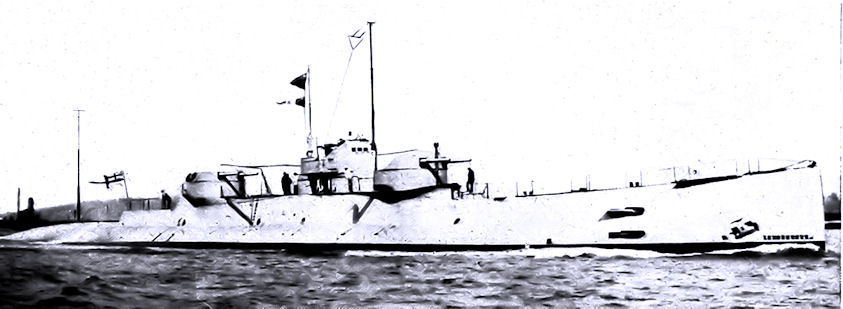
Origins and Genesis
HMS X1 was an experimental cruiser submarine designed for the Royal Navy, a merchant shipping raider. At the time of her launch, she was the world’s largest submarine. The name was later resurrected by experimental midget submarines designed to sink Tirpitz in Norway.
The idea of a submarine cruiser went from as early as 1915, but was not really started -with the mitigated experience of the M class- from 1921. This prototype, rightfully called “X-1” was a close “replica” of the projected, but never completed German U-173, a large U-kreuzer displacing more than 2,000 tons and armed with heavy guns. Indeed, in 1916 already the Kaiserliches Marine ordered the U-139 class, which was put into service as a large, long-range “cruiser submarines” or “U-Kreuzer”.
They were given two single, unshielded 15cm deck guns assorted with a precision rangefinder placed in an armored conning tower. Thus they were perfectly able to inflict substantial damage on any ship while surfaced, while keeping a large reserve of torpedoes for a long campaign partly submerged. After the war Germany was forbidden by the Versailles Treaty to built or operate any submarine and the few U-139 class boats were divided among the Allies. They were carefully studied, leading these to also experiment with this concept for their own information rather than to apply for any doctrine at the time.
The “Project 46” Boats were 300 ft, 2,483 t submerged behemoths. They were enlarged and tailored (for military purposes) versions of the Deutchland unarmed transport sub that made two trip to the US and back in 1916, and was armed in 1917, leading to the development of the U-151 class. Germany had many of such “U-Kreuzer” projected or in construction when the war ended in November 1918.
Read about WW1 German submarines. See also Project 40 steam U-cruiser
So, back to the U-139 class, France obtained U-139 (Schweiger, renamed Halbronn) which inspired the Surcouf (as the X1). U-140 (Weddigen) to the US, sunk as a target, and of course U-141 to Britain, tried extensively until BU in 1923, by the time HMS X1 was in construction. The previous year, the Washington Naval Treaty did not banned submarines (to the relief of France and Italy) but prohibited their use against merchant shipping. Thus, the initial purpose of X1 was being no longer valid, she was redesigned to engage against destroyers and frigates as a long range escort boat.

X1 came was by all purposes and intents Britain’s first experimental raiding submersible cruiser, when work started before 1921. It was largely based on the uncompleted German U-173 class of which plans were obtained by the admiralty, as a war prize. Plans were drawn by the sixth Director of Naval Construction, responsible for the majority of Royal Navy submarine classes in the Great War, designer of the X.1, which was Sir Arthur W Johns (1873-1937).
X1 was laid down on 2 November 1921 at Chatham. Secrecy surrounded the project at any level, the government preventing leaks, confiscating pictures and put on watch all newspapers. In the end, the launch could not be hidden and of course generated a massive publicity round the world.
Final Design of the X1
The final boat diverged of course from U-173 (Project 47?) in many ways. Information is very scarce if not inexistant on this class, which was planned to be completed between the summer of 1918 and January 1919. Due to the inability to find any blueprints of these (which were interned in UK and placed under high secrecy) we can only guess the X1 was a pretty close interpretation, varying only in details.
Hull and general design
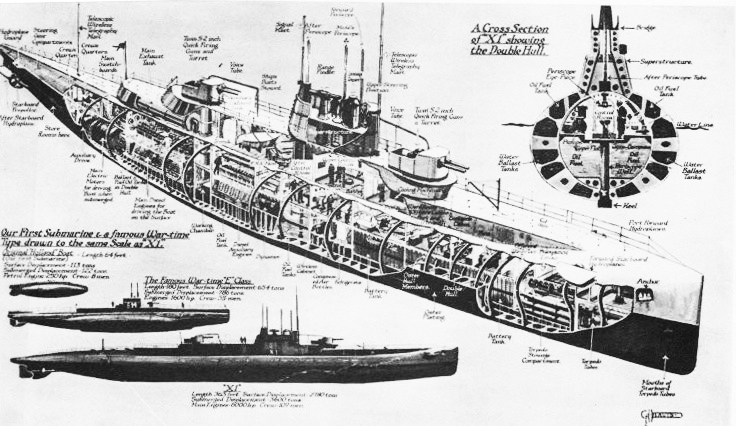
The X1 hull was composed of a thick pressure hull, diameter 19 feet 7.5 inches, divided into 10 watertight compartments containing ballast tanks and fuel tanks. It was built to 1-inch thick (25 mm) to enable greater diving than any other model to circa 500 feet (150 m) which set a world record. Later reduced to 350 feet (100 m) for service. This internal hull was inside a wide external hull, which beam was calculated to give the main artillery good stability, and which contained the main ballast tanks and fuel reserves.
The hull ratio of 360 for 29 feets made for an almost 1/11 ratio favourable for speed, but there was enough buoyancy and with the flat section over the main ballasts to ensure a relatively predictable rolling.
Powerplant
Propulsion comprised two main MAN 8-cylinder diesel engines which developed 3,000 HP and two auxiliary diesel engines (rated 1,200 HP) from a war prize, U-Kreuzer U-126. When diving, the two 1,000 HP electric motors powered by three batteries groups reached 70 tonnes, an unprecedented load for an electric auxiliary power unit, and this ensured both a quick dive and great speed and range underwater, which was also unprecedented for TN submarines.
Armament
Her armament was really unique and stayed son but perfectly in line with the original U-Kreuze project. It consisted in two twin turrets forward and aft of the conning tower.
Each sported a very unusual ordnance, a pair of 130 mm (5-in) guns with a range at maximal elevation of 15,000 m. For better accuracy they were provided data from a large rangefinder installed on the bridge. No AA gun was planned, as it was still unusual in 1921. Would X.1 had been kept for service in WW2, it’s likely the conning tower aft would have been managed as a gun platform and a 2-pdr Pompom installed, or a quad Vickers LC-HMG 0.5-in mount.
Main Battery: Four 5.2 in guns (1924)
These 5.2″/42 (13.2 cm) QF Mark I were absolutely unique to X.1. They were never featured any any other ship in the Royal Navy. In fact they were specifically developed from 1921 for the new boat.
The concept was to create two lighweight, but fast-firing guns which can rapidly disable a destroyer at 6,000 yards (5,500 m), before the latter could engage the submarine with its own artillery, and later its own torpedo tubes. In practice the rangefinder was installed way too low to be of some use. Despite the large hull, the rolling nature of a submarine make it an awkward gun platform, unsteady. The guns were created almost from scratch in a hurry to equip X.1 in secret, and considered reliable after the teething problems were solved in its development.
Ihis was a standard ordnance made by Vickers Armstrong Elswick, from a patered inner A tube and partial jacket plus breech ring. It used a horizontal sliding and hand operated breech block using semi-automatic opening for speed, and only six of these were ever manufactured, the four to be installed and two spares.
Performance-wise, it was fast, with a nominal rate of Fire of 6 rounds per minute. It fired a separate HE round weighting 70 lbs. (31.8 kg) with a 10.78 lbs. (4.9 kg) MC 16 propellant charge, aor 11.36 lbs. (5.2 kg) SC 109 one. Muzzle Velocity was average, 2,300 fps (701 mps), but sufficient to deal with the weak protection of destroyers.
X.1 carried 100 rounds per gun, so 400 total. Max range was on paper 17,288 yards (15,800 m) at 40°. The turrets themselves were peculiar also. They comprised an ovale type platform on top of short, waterproof barbettes communicating to the respective ammo chambers below. The rear of the “bathtub” was open-air and only the forward part were protected, by a light snrapnel-proof hemispheric structure, creating unique “semi-turrets”. To cope with the ammunition consumption and balance the weight, Special ballast tanks were fitted to compensate as the ammunition was fired. Also the gun crew was considerable, 58 total, making for more than half of the full complement of 109.
Torpedo Tubes
The battery comprised six standard 21-inches torpedoes tubes, all in the bow. These six forward torpedo tubes were gathered from a cancelled late order WW1 L-class submarine. They fired the standard British Whitehead pattern 21″ (53.3 cm) Mark IV*. It was powered by wet-heater, Weighting 3,206 lbs. (1,454 kg) for 22 ft 7.5 in (6.896 m) long and carrying a 515 lbs. (234 kg) TNT warhead. Range/Speed had three settings: 8,000 yards/35 knots, 10,000 yards/29 knots and 13,500 yards/25 knots. It is not known how much reloads they carried, but given the boat’s size, we can assume perhaps two reloads per tube (18 torpedoes).

Author’s profile reconstructed from various sources
See this nice colorization and this one or these ones.
⚙ specifications |
|
| Displacement | 2,780 long tons surfaced, 3,600 long tons submerged |
| Dimensions | 363 ft 6 in x 29 ft 9 in x 15 ft (110.8 m x 9.1 m x 4.6 m) |
| Propulsion | 4 MAN diesel 4,200 bhp (3,100 kW), 2 electric motors 1,000 bhp (750 kW) |
| Speed | 19.5 kn (36.1 km/h) surfaced, 9 kn (17 km/h) submerged |
| Range | Surfaced: 12,400 nmi (23,000 km; 14,300 mi) at 12 knots, Submerged: 50 nmi at 4 knots |
| Test Depht | 350 ft (110 m), max theoretical 500 ft (150 m) |
| Armament | 6 × 21 inch (533 mm) bow torpedo tubes, 2×2 5.2 in (132 mm) guns |
| Crew | 111 (11 officers and 100 ratings) |
Career
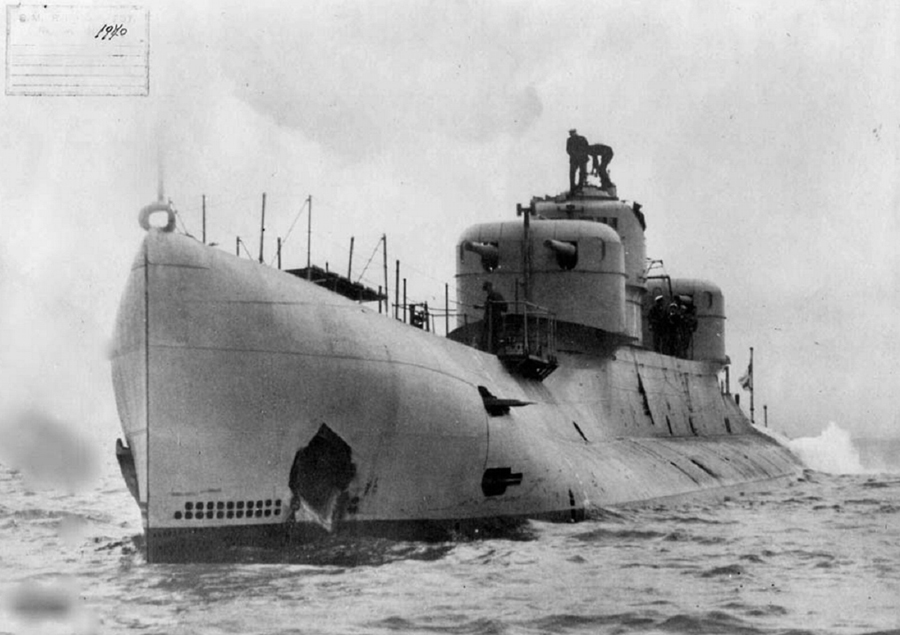
Built at HM Dockyard, Chatham, the Royal Dockyard, behind high walls and armed guards in patrol, with blueprints locked under key and guarded after the workday, X 1 was laid down on 2 November 1921, launched on 16 June 1923 and completed on 23 September 1925. A rather long construction time, twice as much as the late-war L class.
This was explained by the interpretation of German plans and the unique nature of this new “boat”, carrying with it a number of technical challenges. She was indeed the most ambitious and complicated submarine in the Royal Navy, and the world’s largest at the time. The only ones that arrived close with the short M1 serie of 1918.
Thus, X 1 was commissioned at last in December 1925, make her sea trials and initial tests, including a diving test. It showed she was slower than expecting, with 2 min. 20 seconds to disappear below the waves, more than expected. In 1925 this was acceptable, not in 1936. Already her sea trials dragged on. The main issue was her diesels. Although they procured a record 19.5 knots and a long range, they broke out constantly. There was no easy fix and only time the machinery crew enough confidence to maintain a steady regime until she was declared operational, by April 1926.
As soon as she was deemed ready for service, X1 left for Gibraltar. Upon arrival however she needed fixes as the machinery crew was still not accustomed to manage the German main diesel engines, which caused troubles. Once her engines were repaired locally, then she resumed training. And in one of these sorties, she broke her starboard camshaft driveshaft while making a fast run, in January 1928. And this was just one scores of mechanical problems experienced that year alone.
Not of great use for the Mediterranean Fleet until the, the problems accumulated and became so acute that in 1928 she was sent to the Malta Drydock for long repairs as well as an overhaul. It was her “composite German propulsion” that was cited as the main issue.
She was not popular with her crew either, criticized for her too cramped living spaces despite her generous size. As said by her commanding officer: “internal arrangements not satisfactory because of overcrowding with auxiliary machinery, accommodation cramped, poor ventilation and humidity”. It was perhaps the result of a very large gun crew. She served again in 1929-30 but her main and auxiliary engines continued to break down constantly, marring all her trials and training. By the fall of 1930, HMS X1 was considered a failure. She was retired in 1930, and placed in reserve. The admiralty, based on the very poor reviews given in reports estimated a replacement or a redesign. She was kept in reserve from 1932-33.
Then, she was mothballed for more years, pending her fate. Eventually it was estimated that her concept was no longer filling any need in the RN and her mixed nature was decidedly an original problem that was too great to overcome. A rebuilt in this context was judged too costly. The crew was “recycled” in other subamrines rapidly. Eventually in 1936, she was discarded and formally decommissioned, after years in reserve.
She was eventually sold to Pembroke Yard in Wales on December 12, 1936 to be scrapped. With only three years of active service marred woth constant issue and overall bad reviews.
In effect, X 1 “cured” the category of submarine cruisers in the Royal Navy for ever. Despite of this, other nations still trusted the concept or were willing to have a try. These were the US, France and Japan. The first two went through the same rabbit hole, for slighlt different reasons, but the French Surcouf was probably the closest to X 1. the US produced three “cruisers” actually and multiplied blueprints after WWI (this is a topic that will be likely seen here in 2024). These were USS Argonaut (launched 1927) and the Narwhal class (1927 and 1930); They displaced between 3,900 and 4,000 tonnes submerged, so even more than X 1, but were armed with simpler deck guns, albeit 6-in/53 ordance, far above the norm for a US submarine. They were also considered as “white elephants” and still found some utility in WW2, as “spec ops” submarines in a serie of behind enemy lines operations.
Surcouf was largely inspired by X 1, launched in 1929. She carried a pair of 8-in guns, beating the competition, coupled with an observation floatplane. But she was also riddled with issues. She found not more succession or was hard to fit in, and remained for her value in film propaganda of the time. She was lost in the gulf of Mexico in 1942, in unclear circumstances (likely after a collision).
Only the Japanese fully embraced the concept.
They made the “cruiser submarine” an operational type of itself, with a doctrine attached, and produced several successive classes, such as the 4,700 tonnes four “1st class” seaplane carriers of the AM class, the two SH class (4,300 tonnes) and the massive STO class designed to attack the Panama canal (6,500 tonnes). The latter remained the world’s largest submarines until nuclear ones of the 1960s.
Despite of its lackluster career, X1 remained highly influential. She is a paradox. When British diplomats attempted to outlaw submarines as commerce raiders, the Admiralty was meanwhile building in full secrecy the ultimate corsair submarine, capable of destroying entire convoys and their escorts. She was “the first” of a new breed, publicized by the press as the “Royal Navy’s dreadful secret weapon in case of war”, so valuable for morale, and having an indisputable impact on other nations, while resulting in additions in the Washington and London treaty to try to forbid them.

Read More
Books
X1, the Royal Navy mystery submersible by Roger Branfill-Cook.
Links
defensemedianetwork.com/
rebellionresearch.com
navweaps.com/
scribd.com/: X-1-The-Royal-Navy-s-Mystery-Submarine
nmrn.org.uk (submarine-museum site)

 Latest Facebook Entry -
Latest Facebook Entry -  X(Tweeter) Naval Encyclopedia's deck archive
X(Tweeter) Naval Encyclopedia's deck archive Instagram (@navalencyc)
Instagram (@navalencyc)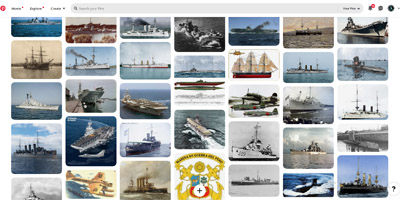



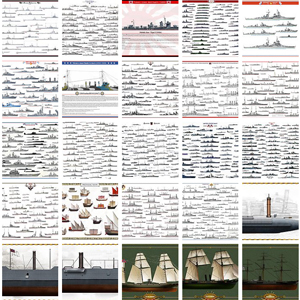
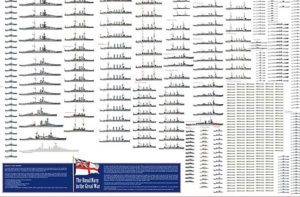
 French Navy
French Navy Royal Navy
Royal Navy Russian Navy
Russian Navy Armada Espanola
Armada Espanola Austrian Navy
Austrian Navy K.u.K. Kriegsmarine
K.u.K. Kriegsmarine Dansk Marine
Dansk Marine Nautiko Hellenon
Nautiko Hellenon Koninklije Marine 1870
Koninklije Marine 1870 Marinha do Brasil
Marinha do Brasil Osmanlı Donanması
Osmanlı Donanması Marina Do Peru
Marina Do Peru Marinha do Portugal
Marinha do Portugal Regia Marina 1870
Regia Marina 1870 Nihhon Kaigun 1870
Nihhon Kaigun 1870 Preußische Marine 1870
Preußische Marine 1870 Russkiy Flot 1870
Russkiy Flot 1870 Svenska marinen
Svenska marinen Søværnet
Søværnet Union Navy
Union Navy Confederate Navy
Confederate Navy Armada de Argentina
Armada de Argentina Imperial Chinese Navy
Imperial Chinese Navy Marinha do Portugal
Marinha do Portugal Mexico
Mexico Kaiserliche Marine
Kaiserliche Marine 1898 US Navy
1898 US Navy Sovietskiy Flot
Sovietskiy Flot Royal Canadian Navy
Royal Canadian Navy Royal Australian Navy
Royal Australian Navy RNZN Fleet
RNZN Fleet Chinese Navy 1937
Chinese Navy 1937 Kriegsmarine
Kriegsmarine Chilean Navy
Chilean Navy Danish Navy
Danish Navy Finnish Navy
Finnish Navy Hellenic Navy
Hellenic Navy Polish Navy
Polish Navy Romanian Navy
Romanian Navy Turkish Navy
Turkish Navy Royal Yugoslav Navy
Royal Yugoslav Navy Royal Thai Navy
Royal Thai Navy Minor Navies
Minor Navies Albania
Albania Austria
Austria Belgium
Belgium Columbia
Columbia Costa Rica
Costa Rica Cuba
Cuba Czechoslovakia
Czechoslovakia Dominican Republic
Dominican Republic Haiti
Haiti Hungary
Hungary Honduras
Honduras Estonia
Estonia Iceland
Iceland Eire
Eire Equador
Equador Iran
Iran Iraq
Iraq Latvia
Latvia Liberia
Liberia Lithuania
Lithuania Mandchukuo
Mandchukuo Morocco
Morocco Nicaragua
Nicaragua Persia
Persia San Salvador
San Salvador Sarawak
Sarawak Uruguay
Uruguay Venezuela
Venezuela Zanzibar
Zanzibar Warsaw Pact Navies
Warsaw Pact Navies Bulgaria
Bulgaria Hungary
Hungary

 Bundesmarine
Bundesmarine Dutch Navy
Dutch Navy Hellenic Navy
Hellenic Navy Marina Militare
Marina Militare Yugoslav Navy
Yugoslav Navy Chinese Navy
Chinese Navy Indian Navy
Indian Navy Indonesian Navy
Indonesian Navy JMSDF
JMSDF North Korean Navy
North Korean Navy Pakistani Navy
Pakistani Navy Philippines Navy
Philippines Navy ROKN
ROKN Rep. of Singapore Navy
Rep. of Singapore Navy Taiwanese Navy
Taiwanese Navy IDF Navy
IDF Navy Saudi Navy
Saudi Navy Royal New Zealand Navy
Royal New Zealand Navy Egyptian Navy
Egyptian Navy South African Navy
South African Navy






























 Ukrainian Navy
Ukrainian Navy dbodesign
dbodesign